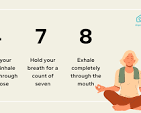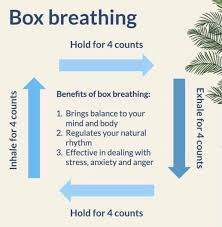Breathing Exercises for Stress Relief
Stress is a common experience in today’s fast-paced world, but it doesn’t have to control your life. One simple and effective way to manage stress is through breathing exercises. By focusing on your breath, you can calm your mind, relax your body, and reduce feelings of anxiety and tension.
Deep Breathing
Find a quiet place where you can sit or lie down comfortably. Close your eyes and take a deep breath in through your nose, allowing your lungs to fill with air. Hold the breath for a few seconds, then exhale slowly through your mouth. Repeat this process several times, focusing on the sensation of the breath entering and leaving your body.
4-7-8 Technique
This technique involves inhaling for a count of 4, holding the breath for a count of 7, and exhaling for a count of
It helps regulate the breath and activate the body’s relaxation response. Practice this technique whenever you feel overwhelmed or stressed.
Box Breathing
Box breathing is a simple yet powerful technique that involves inhaling for a count of 4, holding the breath for 4 counts, exhaling for 4 counts, and holding again for 4 counts before beginning the cycle again. This method can help you focus your mind and calm your nervous system.
Alternate Nostril Breathing
This yogic breathing exercise involves closing one nostril with your thumb while inhaling through the other nostril, then closing that nostril with your finger while exhaling through the opposite nostril. This practice can help balance energy levels and promote relaxation.
Belly Breathing
Belly breathing focuses on diaphragmatic breathing, where you expand your belly as you inhale deeply through your nose and contract it as you exhale through your mouth. This technique can help reduce stress and increase feelings of calmness.
Remember that consistent practice is key to reaping the benefits of these breathing exercises. Incorporate them into your daily routine or use them whenever you feel stressed or anxious to promote relaxation and well-being.
Top 9 FAQs About Breathing Exercises for Stress Relief
- What are breathing exercises for stress?
- How do breathing exercises help in reducing stress?
- What is deep breathing and how does it relieve stress?
- Can breathing exercises be used to manage anxiety?
- Are there specific techniques for using breathing exercises to reduce stress?
- How often should I practice breathing exercises for stress relief?
- Are there different types of breathing exercises for managing stress?
- Can children and teenagers benefit from practicing breathing exercises for stress relief?
- What are the potential benefits of incorporating breathing exercises into a daily routine?
What are breathing exercises for stress?
Breathing exercises for stress are simple techniques that involve focused breathing patterns to help calm the mind, relax the body, and reduce feelings of stress and anxiety. These exercises often emphasize deep, slow breaths that engage the diaphragm and promote relaxation. By practicing breathing exercises for stress regularly, individuals can learn to control their breath, activate the body’s relaxation response, and improve their overall sense of well-being. These techniques are accessible tools that can be used anytime and anywhere to manage stress levels effectively.
How do breathing exercises help in reducing stress?
Breathing exercises are effective in reducing stress by activating the body’s relaxation response. When we engage in focused breathing techniques such as deep breathing, 4-7-8 technique, box breathing, alternate nostril breathing, or belly breathing, we signal to our nervous system that it is safe to relax. These exercises help slow down our heart rate, lower blood pressure, and calm the mind, leading to a reduction in stress and anxiety levels. By bringing our attention to the present moment and regulating our breath, we can shift from a state of tension to one of calmness and clarity, promoting overall well-being and mental resilience.
What is deep breathing and how does it relieve stress?
Deep breathing is a technique that involves taking slow, deep breaths to increase oxygen flow in the body and activate the body’s relaxation response. When we are stressed, our breathing tends to become shallow and rapid, which can contribute to feelings of anxiety and tension. By practicing deep breathing, we can counteract this stress response by slowing down our breath and engaging the diaphragm to fully expand the lungs. This process triggers the parasympathetic nervous system, also known as the “rest and digest” response, leading to a decrease in heart rate, blood pressure, and muscle tension. Deep breathing helps calm the mind, reduce stress hormones like cortisol, and promote a sense of calmness and well-being.
Can breathing exercises be used to manage anxiety?
Breathing exercises can indeed be a powerful tool in managing anxiety. When we experience anxiety, our breathing tends to become shallow and rapid, contributing to feelings of panic and distress. By practicing specific breathing techniques such as deep breathing, 4-7-8 technique, or box breathing, individuals can slow down their breathing rate, increase oxygen flow to the brain, and activate the body’s relaxation response. This can help reduce feelings of anxiety, calm the mind, and promote a sense of peace and well-being. Consistent practice of breathing exercises can be an effective strategy for managing anxiety and improving overall mental health.
Are there specific techniques for using breathing exercises to reduce stress?
When it comes to using breathing exercises to reduce stress, there are indeed specific techniques that can be highly effective. Deep breathing, the 4-7-8 technique, box breathing, alternate nostril breathing, and belly breathing are some of the popular methods known for their stress-relieving benefits. Each technique offers a unique approach to calming the mind, relaxing the body, and promoting a sense of well-being. By incorporating these specific breathing exercises into your daily routine or utilizing them during moments of stress or anxiety, you can harness their power to reduce tension and enhance your overall mental and emotional resilience.
How often should I practice breathing exercises for stress relief?
To effectively manage stress and experience the benefits of breathing exercises, consistency is key. It is recommended to practice breathing exercises for stress relief daily, ideally incorporating them into your routine at least once or twice a day. Taking a few minutes in the morning to center yourself with deep breathing or engaging in a calming breathing exercise before bed can help you relax, reduce tension, and cultivate a sense of inner peace. By making breathing exercises a regular part of your day, you can build resilience against stress and enhance your overall well-being.
Are there different types of breathing exercises for managing stress?
Yes, there are various types of breathing exercises that can help manage stress effectively. Different techniques, such as deep breathing, 4-7-8 technique, box breathing, alternate nostril breathing, and belly breathing, offer unique ways to calm the mind and relax the body. Each type of breathing exercise focuses on different aspects of breath control and relaxation, providing individuals with a range of options to choose from based on their preferences and needs. By exploring these different types of breathing exercises, individuals can discover which techniques work best for them in reducing stress and promoting overall well-being.
Can children and teenagers benefit from practicing breathing exercises for stress relief?
Yes, children and teenagers can greatly benefit from practicing breathing exercises for stress relief. Just like adults, young individuals experience stress and anxiety in various aspects of their lives, such as school pressures, social interactions, and family dynamics. Teaching children and teenagers simple breathing techniques can empower them to manage their emotions, calm their minds, and reduce stress levels effectively. By incorporating breathing exercises into their daily routines, young individuals can develop valuable coping skills that promote emotional well-being and resilience as they navigate the challenges of growing up.
What are the potential benefits of incorporating breathing exercises into a daily routine?
Incorporating breathing exercises into a daily routine can offer a wide range of potential benefits for both physical and mental well-being. These practices can help reduce stress and anxiety levels by activating the body’s relaxation response, leading to a calmer mind and improved emotional stability. Regularly engaging in breathing exercises can also enhance focus and concentration, promote better sleep quality, and increase overall energy levels. Additionally, these techniques can improve respiratory function, boost immune system functioning, and aid in managing chronic pain. By making breathing exercises a part of your daily routine, you can experience heightened relaxation, improved health outcomes, and a greater sense of balance in your life.



